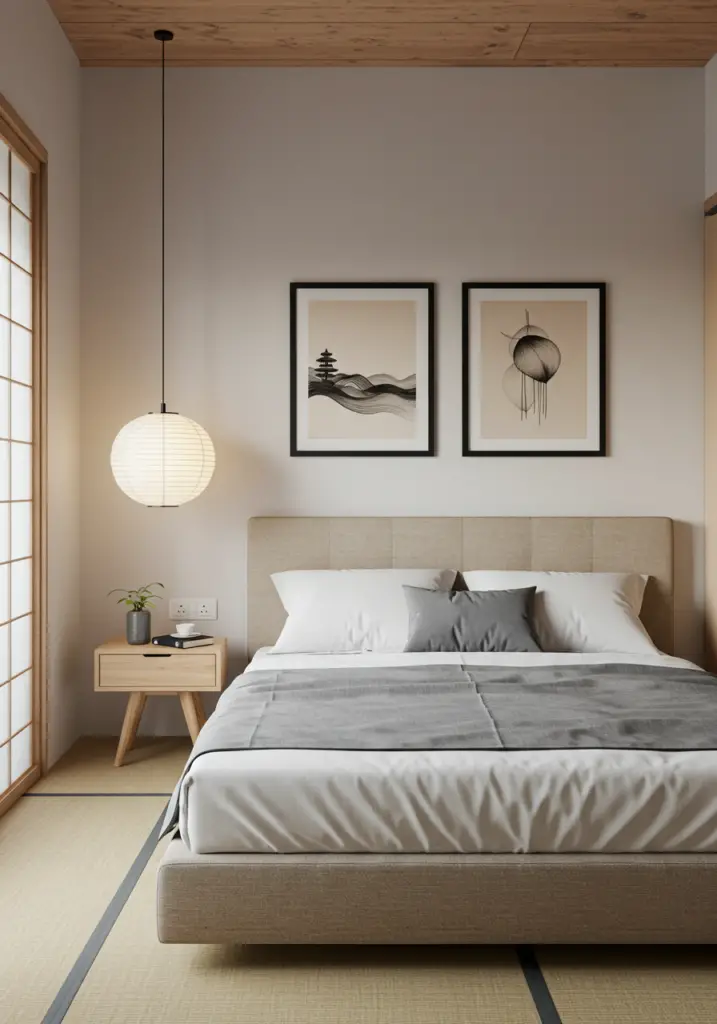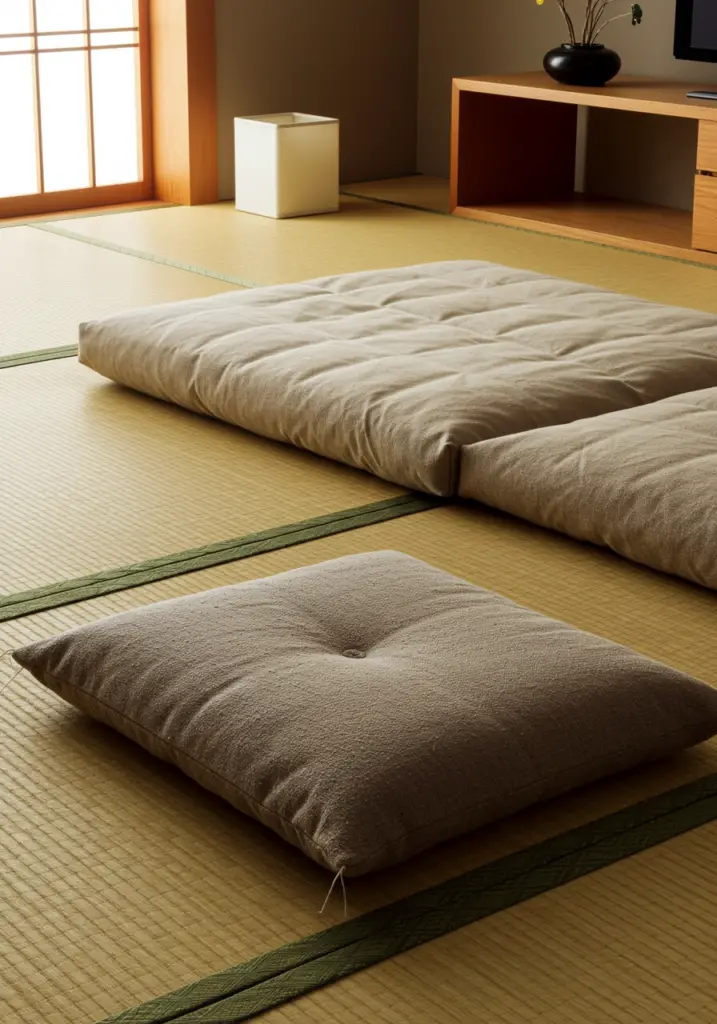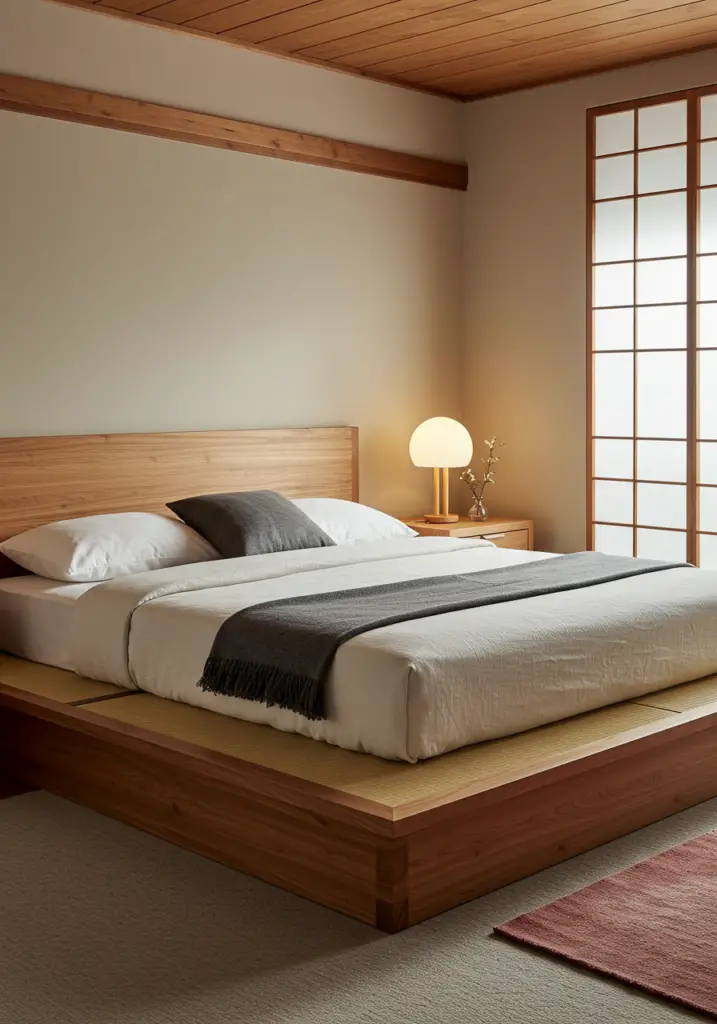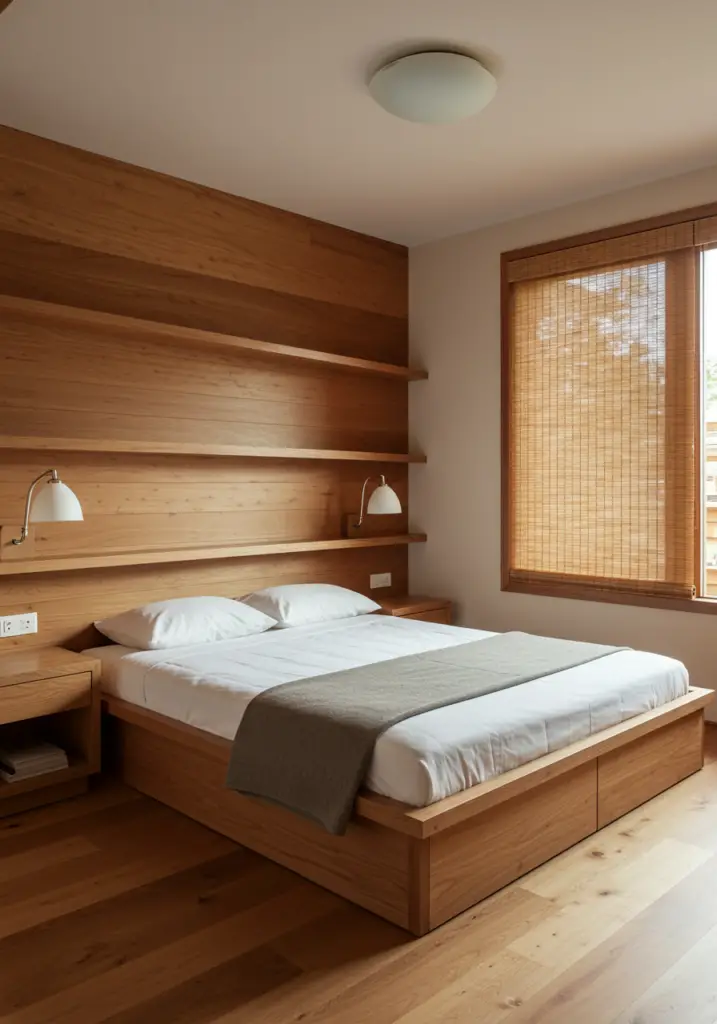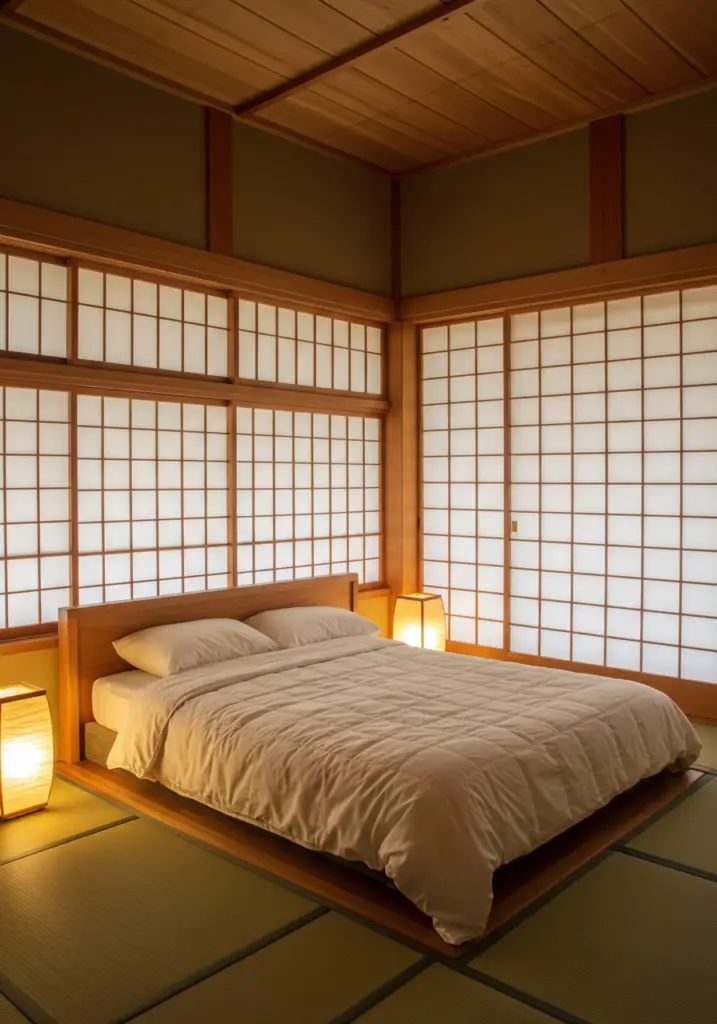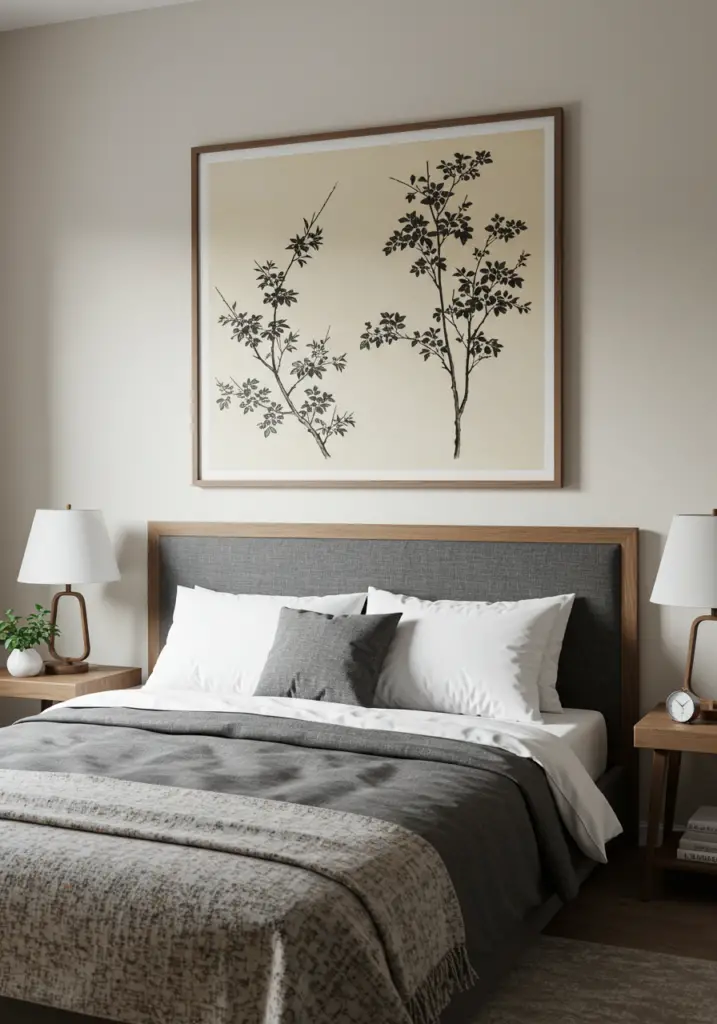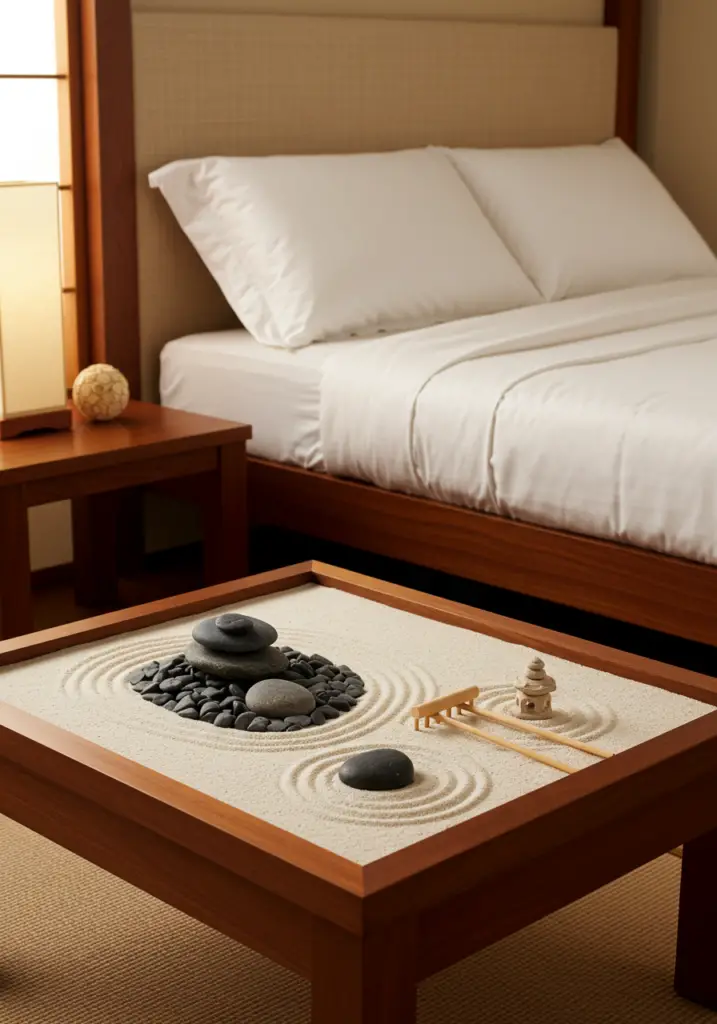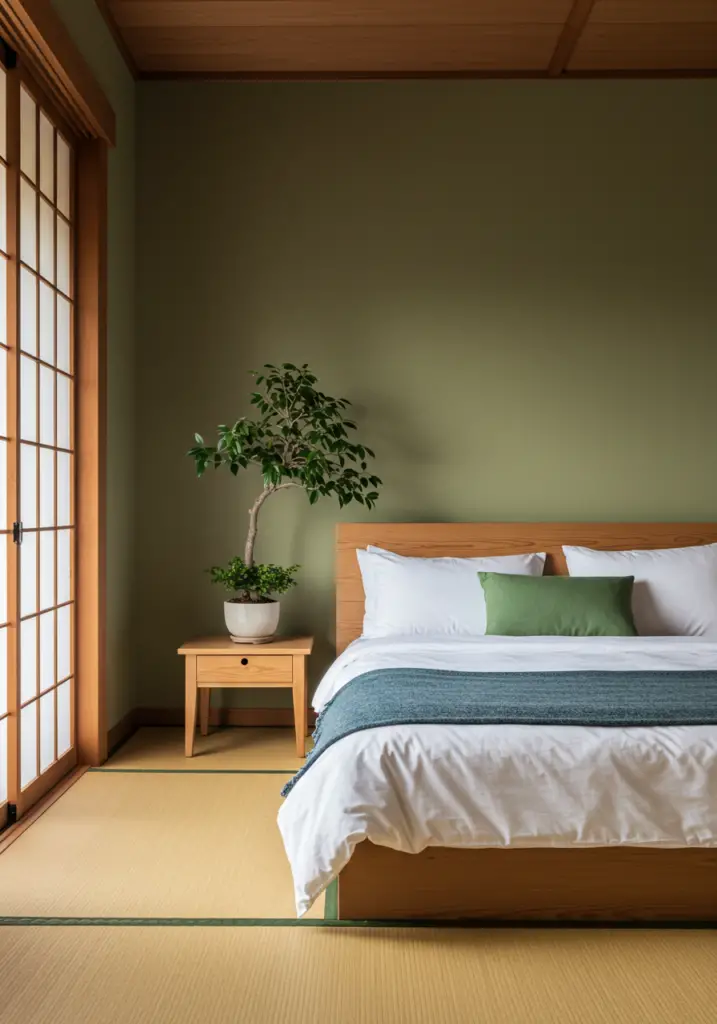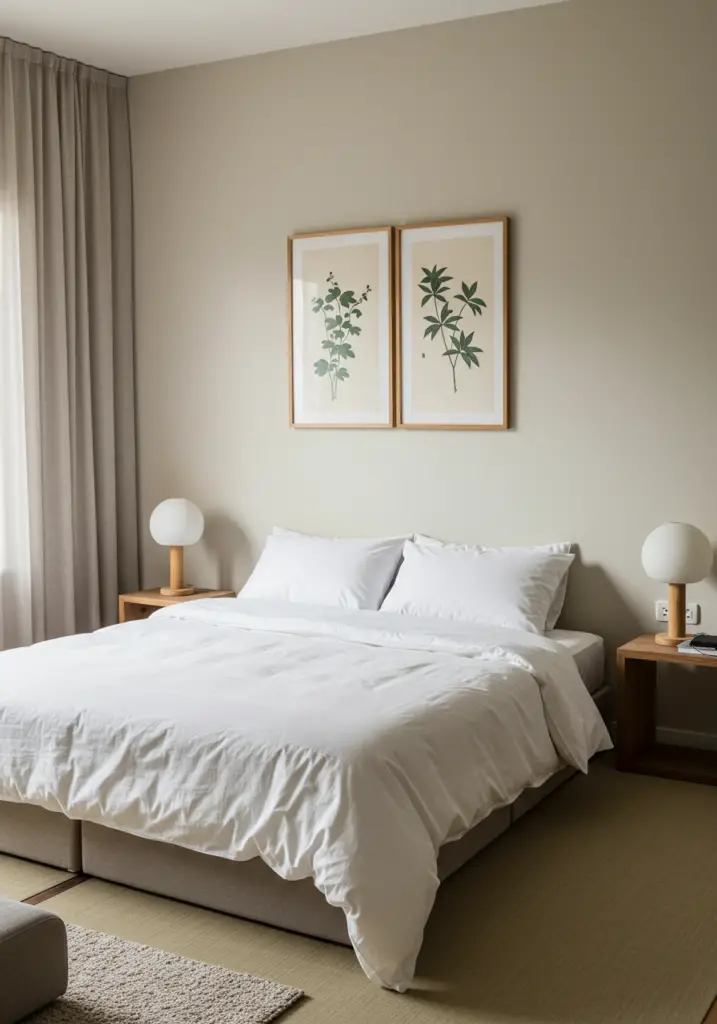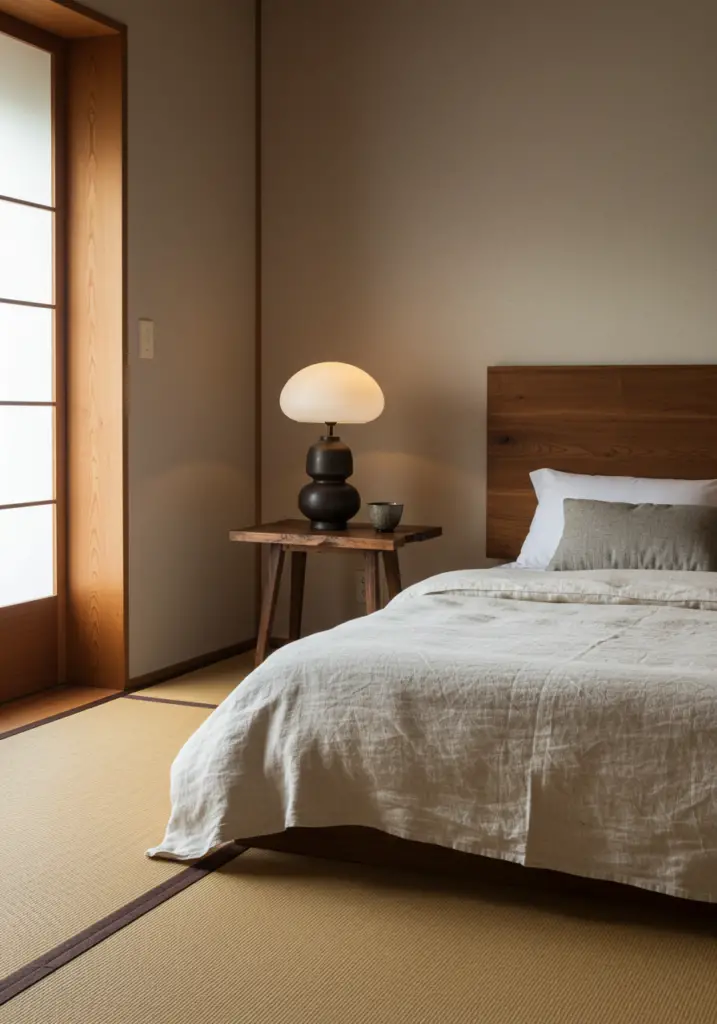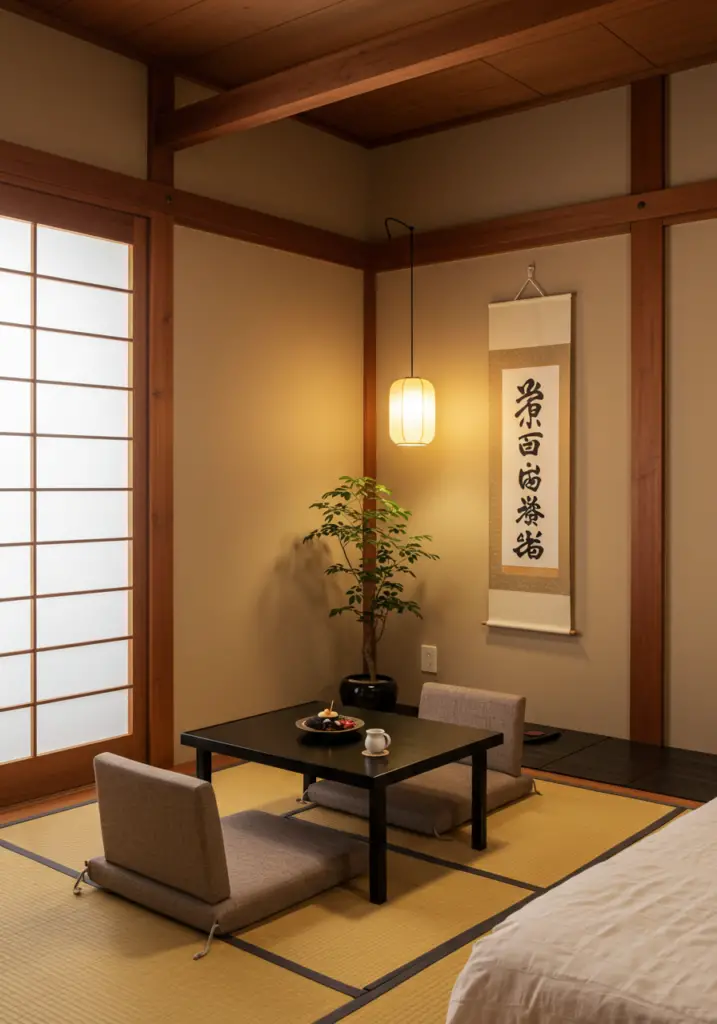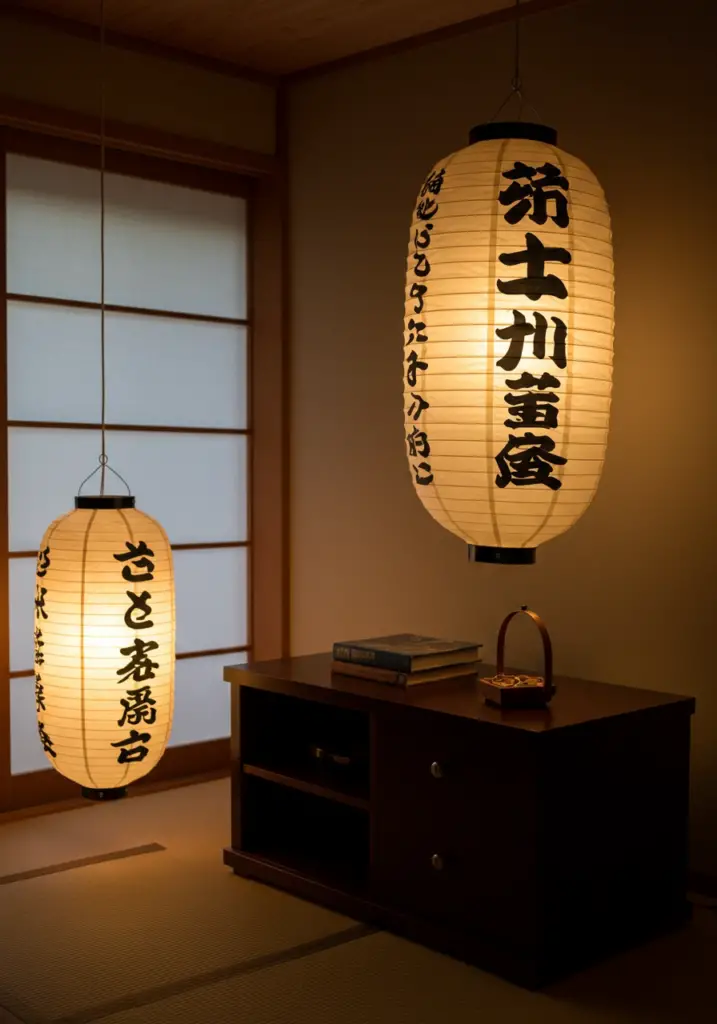If you’re looking to create a peaceful, minimalist retreat in your home, the Japanese bedroom style might be exactly what you need. Known for its simplicity, tranquility, and functional beauty, Japanese design offers a serene ambiance perfect for rest. In this article, we’ll explore 19 captivating ideas to help you embrace this timeless style and bring it to life in your bedroom.
1. Embrace Minimalism: Less is More
At the core of the Japanese bedroom style is the philosophy of minimalism. The focus is on simplicity and functionality, with no excess clutter. This concept is rooted in the Japanese tradition of Zen, which aims to create a calm, uncluttered environment. When designing your Japanese-inspired bedroom, aim to keep the space free from unnecessary items. Use sleek, functional furniture, such as a low-profile bed, a simple nightstand, and a minimalist wardrobe. Opt for neutral colors like white, beige, and gray to keep the mood light and airy. By embracing minimalism, you’ll foster a sense of peace and calm in your bedroom that promotes restful sleep.
2. Tatami Mats for a Traditional Touch
A staple of Japanese interior design, tatami mats are woven straw mats traditionally used as flooring in Japanese homes. They add texture, warmth, and a natural aesthetic to your bedroom. If you want to go for an authentic Japanese bedroom style, consider laying down tatami mats on the floor. These mats create a soft, comfortable surface to walk on, while also evoking the charm of traditional Japanese design. Tatami mats can also be used to designate different areas of the room, creating a sense of balance and organization. Add cushions or low seating on top of the tatami mats for a cozy, inviting atmosphere.
3. Low Bed Frame for a Grounded Feel
In Japanese bedrooms, furniture is often designed to be low to the ground, providing a grounded and calm vibe. A low bed frame, such as a platform or futon bed, is essential in achieving the Japanese bedroom style. The futon bed is a traditional Japanese piece, typically placed directly on the tatami mat, and can be folded up during the day to maximize space. If you prefer a more permanent option, opt for a low-profile platform bed with clean lines and minimal detailing. The idea is to keep your furniture at a lower height to promote a connection with the earth and maintain a peaceful, serene environment.
4. Natural Wood Elements for Warmth and Texture
Incorporating natural wood into your Japanese bedroom design can create a warm, inviting atmosphere. Wood is an important element in Japanese interiors, often used in furniture, flooring, and accent details. You can use light wood tones for a softer, airier feel, or go for darker woods for a more grounded and cozy atmosphere. A wooden bed frame, nightstands, and even shelving units can contribute to a natural, organic look. To enhance the aesthetic, consider incorporating elements like wooden window frames or bamboo blinds, which also provide a sense of privacy and natural light control.
5. Shoji Screens for Privacy and Light Control
Shoji screens are traditional Japanese sliding doors made of wood and translucent paper, and they serve as both decorative and functional elements in Japanese bedroom style. These screens are perfect for dividing spaces, creating privacy, or controlling the amount of light that enters the room. For a truly authentic Japanese feel, incorporate shoji screens into your bedroom. You can use them to separate the sleeping area from the rest of the room or even as a room divider. The soft, diffused light that passes through the rice paper creates a calming, ambient glow, adding to the tranquil atmosphere of the space.
6. Incorporate Japanese-Inspired Artwork
Japanese artwork is known for its delicate beauty and serene nature. To infuse your bedroom with a sense of Japanese artistry, consider hanging pieces that reflect the simplicity and harmony of this style. You might choose traditional Japanese paintings, such as ink wash landscapes or floral motifs, or modern pieces that evoke the same tranquil atmosphere. Minimalist art is also a great choice, as it aligns perfectly with the Japanese bedroom style’s emphasis on simplicity and clean lines. Large framed prints of Japanese calligraphy or serene landscapes can create a focal point in your room while reinforcing the peaceful vibe of the space.
7. Soft Lighting with Paper Lanterns or Pendant Lights
Lighting plays a crucial role in setting the mood of your bedroom. In Japanese interiors, lighting is often soft and diffused, creating a calm, restful environment. Paper lanterns, a classic feature in Japanese decor, provide gentle illumination and can be hung from the ceiling or placed on a side table. For a more modern take on Japanese lighting, consider pendant lights with a minimalist design. Choose soft, warm lighting to avoid harsh glares, which can disrupt the calming atmosphere you’re trying to create. Layer your lighting with floor lamps or table lamps to create a cozy, inviting ambiance at night.
8. Zen Garden Elements for Tranquility
A Zen garden, or Karesansui, is a symbolic garden in Japanese culture designed to promote contemplation and mindfulness. While you might not have the space for a full garden in your bedroom, you can incorporate elements of this tranquil garden style into your room. Consider adding a small tabletop Zen garden, complete with sand, rocks, and miniature rakes, to create a meditative focal point in your bedroom. A Zen garden not only enhances the aesthetics of your space but also serves as a reminder to slow down and enjoy the present moment, making it the perfect addition to your Japanese-inspired bedroom.
9. Japanese Textiles for Softness and Comfort
Textiles play an essential role in creating a comfortable and cozy atmosphere in a Japanese bedroom. Opt for high-quality, natural fabrics like linen, cotton, and silk, which promote comfort and relaxation. Consider adding Japanese-inspired bedding, such as a duvet cover featuring delicate floral patterns or traditional motifs like cranes or cherry blossoms. Throw pillows and cushions made from soft fabrics add layers of texture and comfort to your bed, creating a warm and inviting space. You can also drape a soft throw blanket over your bed or seating area for added coziness and warmth.
10. Greenery and Indoor Plants for Freshness
Bringing nature indoors is a key element of Japanese bedroom style. Incorporating plants into your room not only adds a touch of greenery but also contributes to a calm, serene environment. In Japanese culture, plants are seen as symbols of vitality and renewal, making them an excellent choice for a bedroom. Consider placing low-maintenance indoor plants, such as bonsai trees, peace lilies, or bamboo, around your space. The presence of greenery will not only enhance the aesthetics but also purify the air, contributing to a healthy and tranquil sleeping environment.
11. Incorporate Bamboo Elements for Natural Beauty
Bamboo is a quintessential material in Japanese design, and its clean lines and natural beauty make it a perfect fit for a Japanese-style bedroom. Bamboo can be incorporated in many ways, such as bamboo flooring, bamboo furniture, or bamboo accents like blinds and lamps. Bamboo adds a natural texture and an earthy feel to the room, further enhancing the minimalist aesthetic of the Japanese bedroom style. To keep things simple, use bamboo in small doses, like bamboo shelving, wall art, or a bamboo headboard for your bed. It’s a timeless material that fosters a calm, Zen-like atmosphere in the space.
12. Futon Bedding for Authenticity
To fully embrace the Japanese bedroom style, consider opting for futon bedding, a traditional Japanese sleep system. Futons are placed directly on the floor or a tatami mat, which allows for easy storage and a more grounded sleeping experience. In the morning, you can fold the futon and store it in a closet, making your bedroom feel more spacious during the day. The simplicity and functionality of futon bedding are key characteristics of Japanese design. To enhance the comfort of the futon, choose natural, breathable fabrics like cotton or linen for the bedding. The futon concept promotes a minimalist lifestyle while offering a restful sleep experience.
13. Simplicity in Color Palette
A neutral and subtle color palette is one of the cornerstones of the Japanese bedroom style. To create a harmonious and calming atmosphere, focus on natural tones such as white, beige, soft grays, and muted browns. These colors help to reflect light and make the room feel larger and more peaceful. You can also introduce hints of nature-inspired colors like moss green, terracotta, or soft blues to create balance and calm. Avoid bold or vibrant colors that might overwhelm the senses. By keeping the color scheme muted and cohesive, you’ll achieve a soothing and elegant look that perfectly embodies the Japanese bedroom style.
14. Wabi-Sabi Aesthetic: Embrace Imperfection
Incorporating the Wabi-Sabi philosophy into your Japanese bedroom style can deepen the authenticity and emotional impact of the space. Wabi-Sabi embraces the beauty of imperfection, transience, and simplicity. Consider integrating items that are naturally imperfect, such as handmade pottery, textured fabrics, or weathered wooden furniture. These items add character and authenticity to your bedroom. Wabi-Sabi also encourages you to let go of perfectionism, so embrace pieces that have a story, whether it’s an antique item or a cherished family heirloom. The Wabi-Sabi aesthetic helps to cultivate a space of reflection and mindfulness, perfect for a bedroom designed for relaxation.
15. Sliding Doors to Maximize Space
Sliding doors are a key feature in Japanese design, not only for their functionality but also for their ability to create a seamless, open flow between rooms. Incorporating sliding doors into your bedroom can save space while adding a traditional Japanese touch. These doors are often made of wood or shoji-style paper, allowing light to filter through while maintaining privacy. You can use sliding doors as closet doors, or even as a way to separate the sleeping area from other parts of the room. The sleek, sliding mechanism enhances the minimalist feel of the room and promotes a clutter-free environment.
16. Create a Meditation Nook
Incorporating a meditation nook into your Japanese-inspired bedroom can help cultivate a peaceful and mindful atmosphere. Meditation is a significant practice in Japanese culture, and creating a designated space for quiet reflection and mindfulness can bring an added layer of tranquility to your room. Choose a corner or a small alcove in your bedroom and furnish it with a cushion or floor seating, a low table, and perhaps a small indoor plant or a Zen garden. This calming space provides an opportunity for daily meditation, reading, or simply taking a moment of solitude and relaxation in the midst of your daily routine.
17. Natural Stone Accents for Tranquility
Incorporating natural stone into your Japanese bedroom style can enhance the sense of calm and balance in the space. Whether through stone flooring, a stone accent wall, or stone decorative elements like sculptures or vases, this natural material introduces a grounding element to the room. Stones such as granite, slate, or river rocks can be strategically placed around the bedroom to add texture and visual interest. Natural stone ties in beautifully with other organic elements like wood and plants, making it a perfect addition to a Japanese-inspired design. The rough texture and earthy tones create a harmonious and Zen-like atmosphere.
18. Serene Color Gradients with Ombre Walls
For a more modern take on the Japanese bedroom style, consider using ombre painting techniques to create serene color gradients on your walls. This subtle, fading effect creates a calming visual experience as the colors gradually transition from light to dark. Shades of light blue, soft gray, or even white fading into deeper tones like charcoal or midnight blue evoke the peacefulness of a Japanese sunset or the stillness of a quiet river. The soft color gradient is perfect for creating an atmosphere of serenity, and it pairs beautifully with minimalist furnishings and natural elements.
19. Incorporate Japanese Lanterns for Soft Lighting
Japanese lanterns, also known as “chochin,” are a fantastic way to bring soft, ambient lighting into your bedroom while adhering to the Japanese bedroom style. These lanterns are made from paper or fabric and are often designed with traditional motifs or simple, elegant shapes. They offer a warm, diffused light that can create a peaceful, intimate atmosphere. You can hang them from the ceiling, place them on side tables, or use them as accent lighting near the floor. A few well-placed lanterns can transform your bedroom into a serene, tranquil haven, perfect for relaxation.
Conclusion:
By incorporating these 10 ideas into your space, you can transform your bedroom into a serene, peaceful retreat inspired by Japanese bedroom style. From minimalistic furniture and tatami mats to soft lighting and natural wood elements, each aspect of this style promotes a sense of tranquility and harmony. Whether you choose to embrace the traditional aspects of Japanese design or opt for a more modern interpretation, the key is to create a calming environment that fosters relaxation. So, start incorporating these elements into your bedroom today, and enjoy the peaceful ambiance of a Japanese-inspired sanctuary in your home.
Frequently Asked Questions
- What is the Japanese bedroom style?
The Japanese bedroom style focuses on minimalism, simplicity, and tranquility. It emphasizes natural materials, neutral colors, low furniture, and functional decor to create a calm, clutter-free environment perfect for rest.
- How do I create a minimalist Japanese bedroom?
To create a minimalist Japanese bedroom, keep only essential furniture like a low bed or futon, and opt for neutral colors like whites, grays, and soft earth tones. Incorporate natural materials such as wood and bamboo, and avoid excess decor for a clean, serene space.
- What furniture should I have in a Japanese bedroom?
Essential furniture for a Japanese bedroom includes a low-profile bed (platform or futon), simple nightstands, and a minimalist wardrobe. The key is functional, unobtrusive furniture with clean lines, avoiding overly ornate or bulky pieces.
- What role do tatami mats play in a Japanese bedroom?
Tatami mats are traditional straw mats that provide a natural, comfortable surface to sit or sleep on. They are often used as flooring or beneath a futon in a Japanese bedroom, adding texture and an authentic touch to the design.
- How can I incorporate natural lighting in a Japanese bedroom?
Natural lighting is important in Japanese design, often diffused through shoji screens or paper lanterns. Soft, ambient lighting creates a calm and peaceful atmosphere, and large windows are preferred to let natural light flood the room while maintaining privacy.
- What is Wabi-Sabi, and how does it relate to Japanese bedroom decor?
Wabi-sabi is a Japanese philosophy that embraces the beauty of imperfection and transience. In a bedroom, this could mean incorporating handmade, rustic furniture or decor with natural imperfections, contributing to a more authentic, organic, and tranquil atmosphere.
- Can a Japanese bedroom style work in a small space?
Yes, the Japanese bedroom style is perfect for small spaces due to its minimalist approach. Low-profile furniture, tatami mats, and sliding doors can help maximize space, creating an open and uncluttered environment that feels larger than it is.


